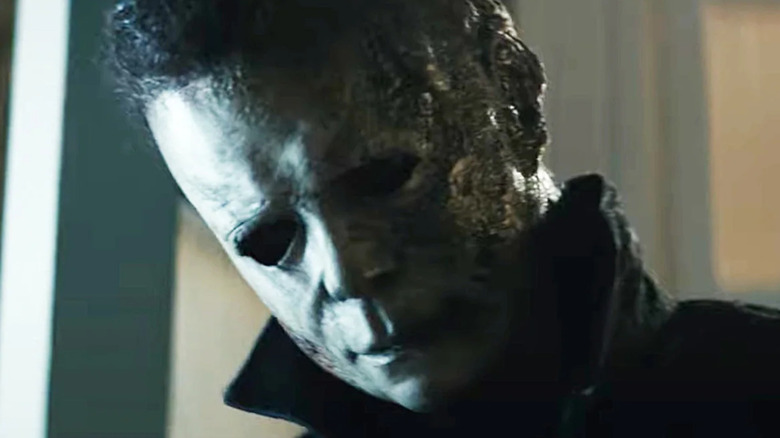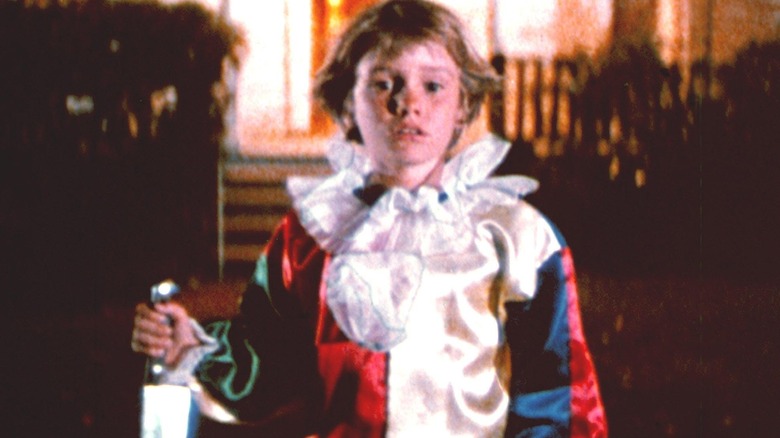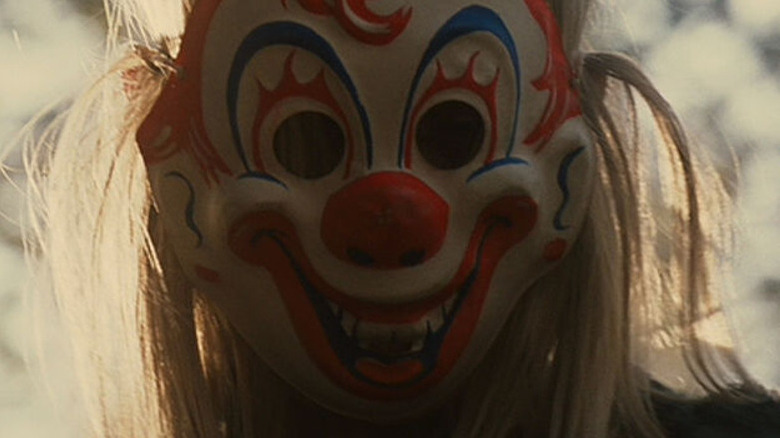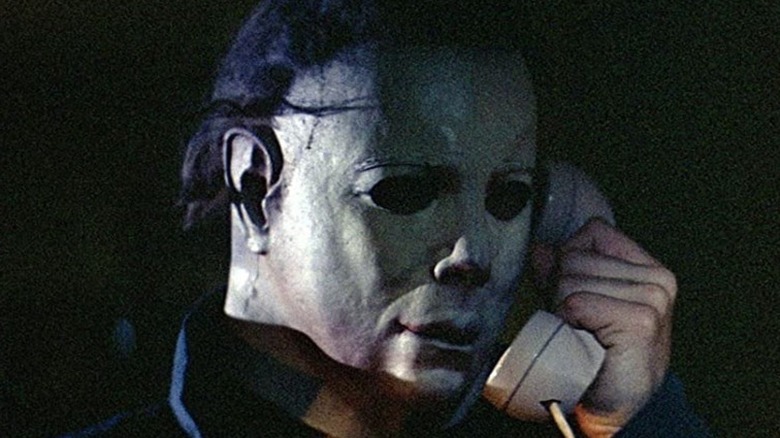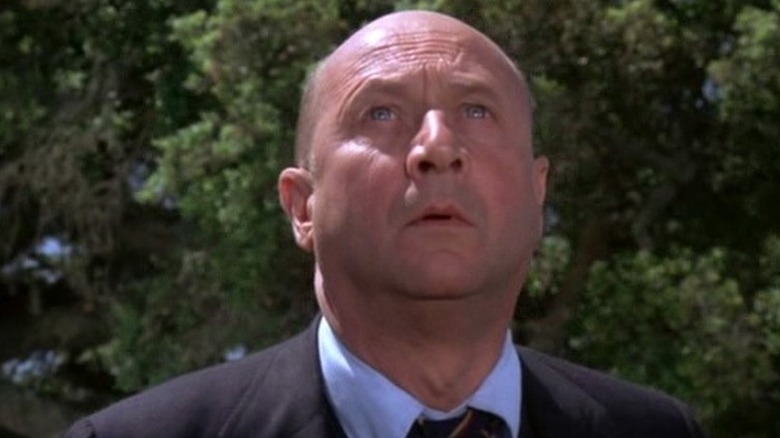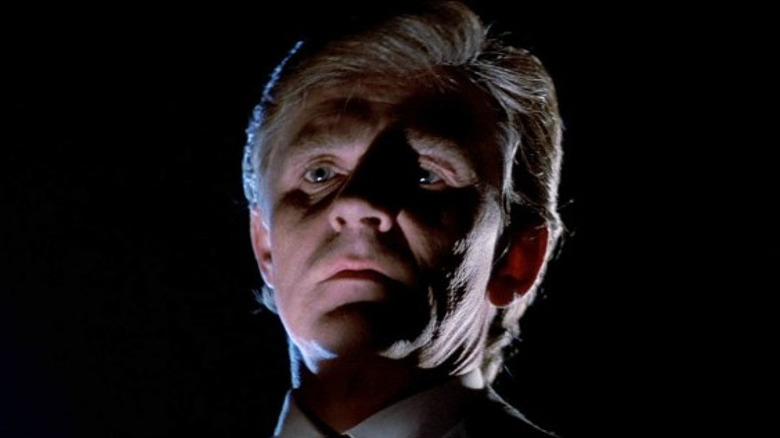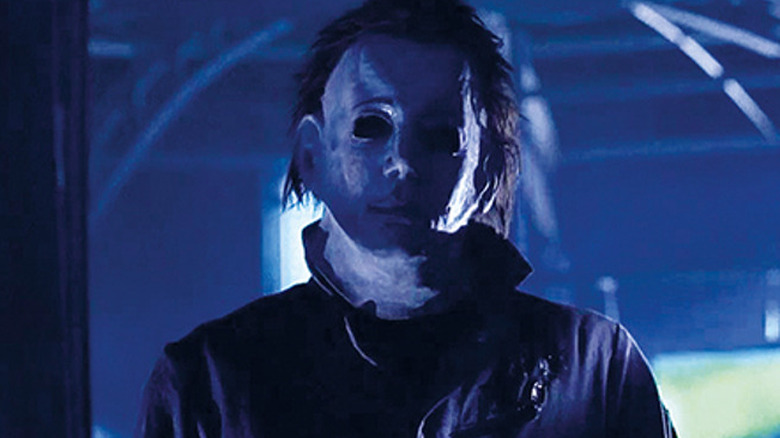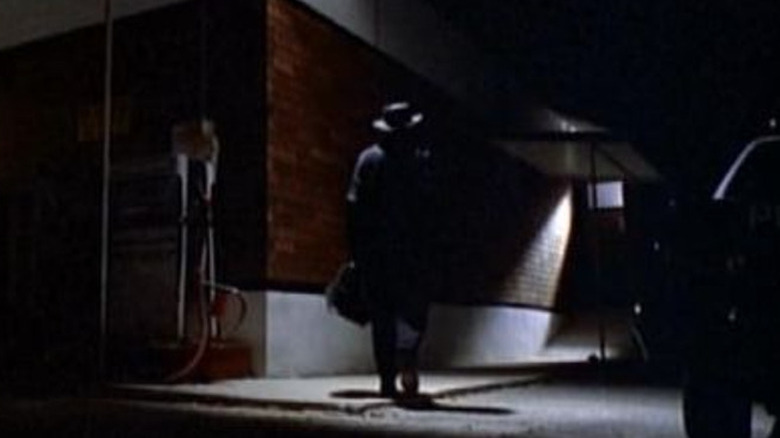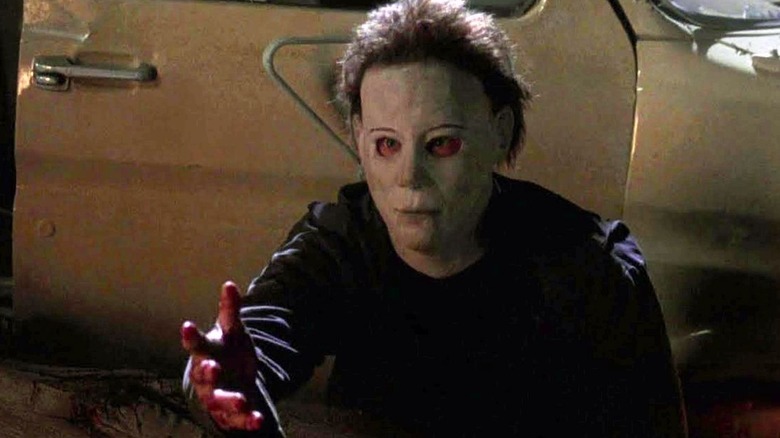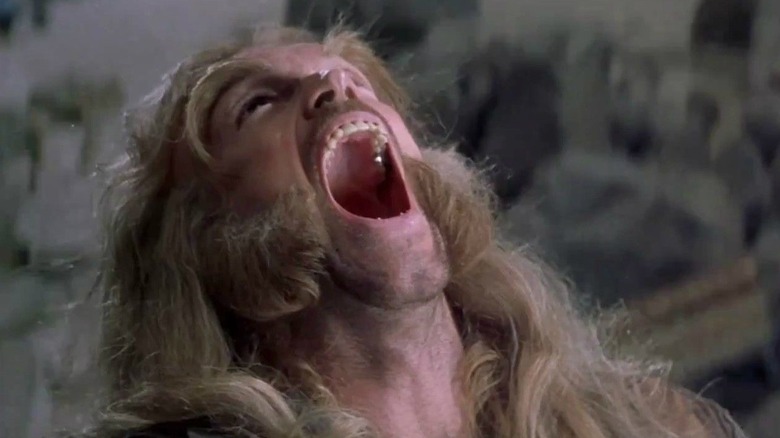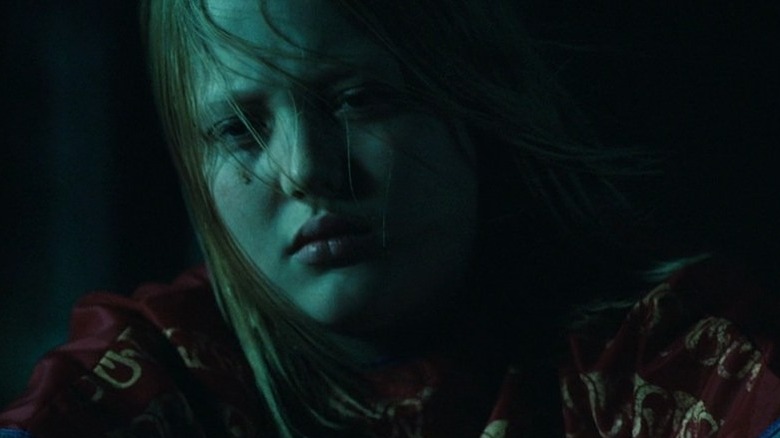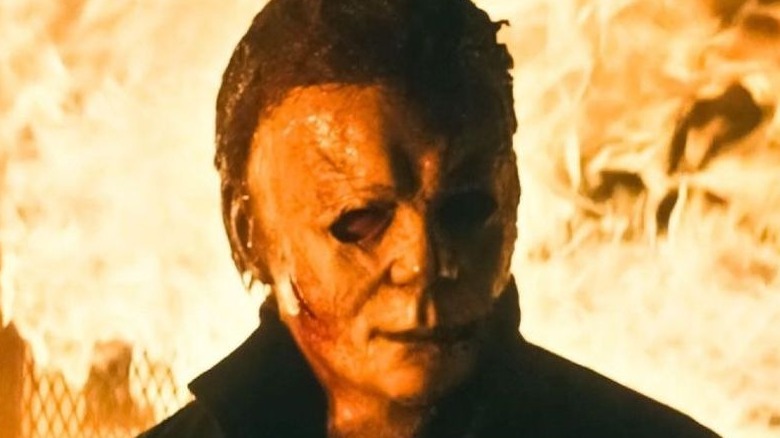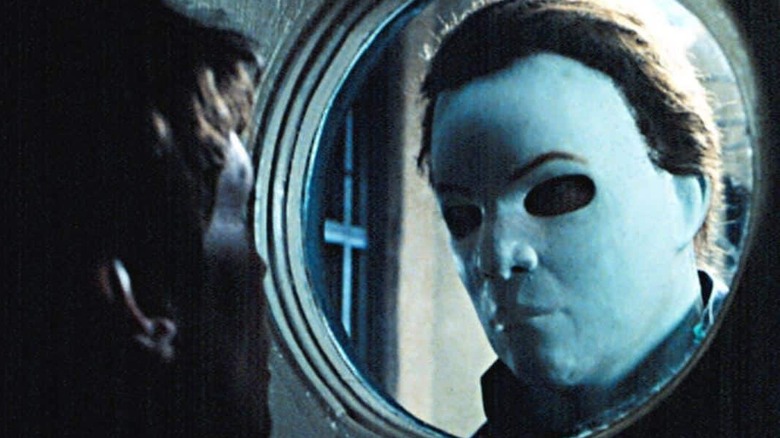The Untold Truth Of Halloween's Michael Myers
If there were a Mount Rushmore of horror icons, Michael Myers would certainly be up there. He is one of the original slasher movie mascots and has survived multiple decades' worth of evolution, retcons, and complete reinvention. His mask, his name, and his brutal methods are synonymous with the horror genre, and it doesn't seem like he'll be leaving the public consciousness anytime soon.
The character's backstory (murdering his older sister on Halloween night), the mythology surrounding him (the boogeyman, an embodiment of pure evil), and his supernatural ability to just keep killing have all become legends within the horror community and the wider audience as a whole. So, there's very little more to say regarding the character within the world of the "Halloween" franchise.
Instead, we'll be taking a look at little behind-the-scenes facts regarding the character that aren't as widely discussed. From his real-life inspiration to unfulfilled plotlines, this is the untold truth of Halloween's Michael Myers.
He was inspired by a real person
It's hard to believe that such an evil force of nature like Michael Myers could actually exist. Based on the way Dr. Loomis talks about him throughout the film and several of its sequels, Myers seems more like an ancient figure from folklore rather than a human being. However, co-writer and director John Carpenter credits the creation of Michael Myers to a school trip where he and his peers visited a mental asylum.
According to Esquire, John Carpenter discussed this fateful trip in the documentary "A Cut Above the Rest." The filmmaker said, "We visited the most serious, mentally ill patients. And there was this kid, he must have been 12 or 13 and he literally had this look." That image obviously stuck with him as it is instantly evocative of the original "Halloween" film's opening where a young Michael Myers is unmasked and stares into the camera with a — in the words of Dr. Loomis — "blank, pale, emotionless face."
He could have been a clown
By now, it's fairly common knowledge that Michael Myers' iconic mask was actually an augmented William Shatner mask. According to filmmaker Tommy Lee Wallace, who worked behind-the-scenes on the original "Halloween," the script contained no description of what Michael Myers' mask actually looked like. While on a panel, Wallace explained, "The script asked for a blank-faced mask." He went on to elaborate that they never referred to the killer as Michael Myers — he was always "The Shape," and he required a "blank-faced mask that makes you feel eerie."
With no specific instructions from John Carpenter, Wallace went to a costume shop on Hollywood Boulevard looking for the perfect mask. He could have gone with Richard Nixon or Gerald Ford, but they looked too much like cartoons. The William Shatner mask just looked like a human face. As a backup, he also purchased a mask based on the Emmett Kelly clown character Weary Willie, because it also struck him as eerie.
While they ultimately picked the Shatner mask, young Michael does wear a clown mask when murdering his sister, and Tommy Lee Wallace did get to bring an eerie clown to the screen when he directed the 1990 TV adaptation of Stephen King's "It."
A lot of people played Michael Myers
Since Michael Myers is just a guy in a mask — almost anyone could play the part. Filmmaker and longtime friend of John Carpenter Nick Castle gets the credit as "The Shape" in the credits of the first film, but he wasn't the only actor to inhabit the role in this movie.
During the opening of the film, a young actor named Will Sandin plays the 6-year-old Michael who brutally murders his older sister. We see his face when the clown mask is ripped away for a shocking reveal. During the climax of the film, Michael's mask is torn off again, and this time, he's played by actor Tony Moran.
However, they weren't the only actors responsible for bringing one of cinema's greatest boogeymen to life in 1978. None other than producer and co-writer Debra Hill had to step in to play the role of 6-year-old Michael's hands. The point-of-view sequence was so complicated that the filmmakers were unable to bring in another child to be Michael's hands. Hill explained, "We couldn't afford another kid to hold the knife later that night, so that's my hand holding the knife that stabs Michael Myers' sister. I had the littlest hands."
Donald Pleasence and Michael Myers met before
The antagonistic relationship between Dr. Loomis and Michael Myers provides the franchise's mythic undertones. Loomis' determination to end Michael's reign of evil is similar to Abraham Van Helsing hunting down Dracula or Captain Ahab obsessing over the white whale who took his leg. The two characters have a long history together as it was Loomis who tried to treat Michael following the original murder. No one knows Michael better than Loomis.
That connection runs even deeper when you realize that the actor who played Loomis, Donald Pleasence, worked with Dick Warlock (Michael from the original "Halloween II") on the 1975 Disney film "Escape to Witch Mountain." Warlock did stunt work on the film, and he described what it was like to work with Pleasence while talking to the website Halloween Daily News. He said, "I found him to be a gentleman. People have said that he had a sense of humor, but I never saw it. When he came on set, he was ready to work, he knew your dialogue and mine. He was the consummate professional. You couldn't find anybody who was better to work with. Never had a complaint, was always ready when they were ready. The rest is history."
Another fun "Escape to Witch Mountain" and "Halloween" connection: The co-star of that film was Kim Richards, older sister of Kyle Richards, who played Lindsey Wallace in both "Halloween" and "Halloween Kills."
He's in Halloween III
"Halloween III: Season of the Witch" is usually referred to as "The 'Halloween' movie without Michael Myers." On the surface, this is a totally fair statement. While "Halloween" and "Halloween II" are one continuous story detailing the night Michael Myers came home and massacred the people of Haddonfield, the third installment was intended to take the franchise in another direction.
In the documentary "Stand Alone: The Making of Halloween III: Season of the Witch," director Tommy Lee Wallace explains the change in direction and the overall concept for an anthology of horror films. He says, "Each year, let's come out with a new movie on the subject of Halloween, All Hallows' Eve, and everything that comes with it. It could go in any direction it wants, and each one could spinoff any number of their own sequels."
The film didn't do very well (via The Numbers), and Michael Myers returned in "Halloween 4: The Return of Michael Myers." Still, Myers' presence is felt in the movie. Dick Warlock, who played Michael in "Halloween II," appears as a quiet, efficient killer who is reminiscent of Myers. Also, a TV spot for the 1978 original film featuring Michael Myers is shown on television in "Halloween III." He may not be the presence audiences were hoping for, but he is in the film.
John Wayne gave us Michael for Halloween 4 and 6
One of the few actors to play Michael Myers more than once is George P. Wilbur, who portrayed The Shape in "Halloween 4: The Return of Michael Myers" and "Halloween: The Curse of Michael Myers." The stuntman/actor behind the mask for those two installments credits John Wayne with his career in show business. While talking to Racks & Razors, George detailed his first job in the film business.
After serving in the navy, Wilbur got a job at a dude ranch in Tucson. "They were filming the movie 'El Dorado' nearby, so I went to the set and got a job as an extra and a stand-in for John Wayne," he said. "Shortly afterward, I moved to Los Angeles to pursue a career as a stuntman."
That career certainly paid off as he went on to add over 100 credits to his name and got to play The Shape not once but twice, all thanks to John Wayne.
He was almost the Man In Black
"Halloween 5: The Revenge of Michael Myers" is a flawed film, to say the least. While the fourth installment did an excellent job of bringing the franchise back to basics, part five tried to push things into surreal territory. One of its more bizarre concepts was depicting a mysterious Man in Black with the same tattoo as Michael, roaming around Haddonfield and breaking Michael out of prison at the end.
In the sixth film, he was revealed to be Dr. Terence Wynn, a character with only one scene in the original Halloween. However, that wasn't always the intention. In an interview with Halloween Daily News, Don Shanks — the actor who played Michael in part five — said director Dominique Othenin-Girard originally wanted Michael to be the Man in Black. He said, "Dominique was saying that for the sequel, I was going to be the Man in Black because I played him too. I did bits and pieces, I didn't do all of him, but there would be scenes where I'd go out one door here and I'd just put on the coat and come through the other door."
He further explains that they were hoping to do something similar to the Brian De Palma film "Raising Cain" and have the audience wonder what the reality around the Man in Black is, but the idea was dropped. As underwhelming as the Dr. Wynn reveal was, having Michael be the Man in Black would've been just plain confusing.
He was supposed to die in H2O
The first attempt to reboot the "Halloween" franchise by ignoring a bunch of sequels came in 1998, 20 years following the original film. The idea of picking up Laurie's story came from Jamie Lee Curtis herself, as she explains in this Q&A from 2012. The film resulting film is "Halloween H2O: 20 Years Later." It ignored everything after "Halloween II" and was supposed to depict Laurie taking down Michael once and for all.
As the project continued, however, Curtis was reading scripts that left Michael's demise to be ambiguous. She demanded to know what was going on because they had agreed to definitively kill Michael at the end of the film. That's when she learned that producer Moustapha Al Akkad, who had control over the character, included a clause in the contract that said Michael Myers cannot be killed.
A compromise was made, and a new ending with Laurie chopping off Michael's head was produced. The idea was it would make the audience feel like Michael is finally, officially dead, but they could easily explain it away in the following film. Indeed, its successor revealed that Michael had crushed a man's larynx and dressed him in his clothes, allowing the killer a chance to escape, thus robbing the audience of a thoroughly satisfying ending to "Halloween H2O."
X-Men Origins
When the time came to officially reboot the "Halloween" franchise and start from scratch, Rob Zombie was brought in to remake the original film in his own vision. He decided his Michael Myers should be the most visually intimidating Michael of all and cast the 6-foot 9-inch' actor and former professional wrestler Tyler Mane. Although his face is obscured through most of the film, audiences recognized him as the mutant Sabertooth from 2000's "X-Men."
As it turns out, he would not be the only "X-Men" film alum to play the character. In the 2002 film "Halloween: Resurrection," Michael was played by stuntman and actor Brad Loree. Just one year later, Loree would be seen briefly playing a 40-year-old William Stryker, the man in charge of the Weapon X program responsible for Wolverine's adamantium skeleton.
Both characters are crucial parts of Wolverine's past, and both would be recast in the prequel film "X-Men Origins: Wolverine." Still, it's nice to see two Michael Myers actors connected by another massive franchise in addition to "Halloween."
Young Michael's future was too intense
The 2007 remake of "Halloween," directed by Rob Zombie, is a darker, more brutal, and more excessive movie than the original. Other than a few moments here and there, a young person could watch John Carpenter's "Halloween" and walk away relatively unscathed. The reboot, however, is so violent and crude that not even the actor who portrayed Michael Myers as a child was allowed to read the entire script.
During an interview with Movieweb to promote the film, actor Daeg Faerch told him his mother only let him read the first act of the script. "I only read my part," the actor said. "And then my mom read it and said, 'You're not gonna read that." Once the film was finished, he still wasn't allowed to see it. Regarding the approaching premiere, he said, "I am going to be kept away, even for the premiere. I'm gonna watch probably the first 10 or 15 minutes where there's no killing, it's just like still kind of horror, but no killing. And then go out and do something else."
Given the film's onslaught of profanity, grotesque violence (including rape), and grisly murders, it's easy to agree with Tyler Mane's assessment from the same interview that it was probably a good idea to keep Faerch away.
The past and present merged in Halloween Kills
"Halloween" was directed by David Gordon Green and released in 2018. It was the third attempt to reboot the franchise and the second film to do so by largely ignoring the sequels. This one went one step further by also ignoring "Halloween II." The filmmakers worked hard to honor the original by bringing back both Jamie Lee Curtis and John Carpenter. Another tribute for hardcore fans to get excited over was bringing back Nick Castle to occasionally embody the role he helped originate.
Castle didn't play the character for any large stretch of time in the film, but it was great to have him back. The latest actor to portray Myers is James Jude Courtney, and he said in an interview with Halloween Daily News that although Nick wasn't on set for "Halloween Kills," his voice was used extensively. "So when I'm stalking and you hear the breathing in the mask, it's Nick Castle breathing, which I think again is very poetic, because Nick is the spirit of this character," Courtney said. "It's Nick's spirit that I reached in and grabbed to manifest the 2018 character."
His fans are important
While it's safe to say that every Michael Myers actor is appreciative of their fans, one story from "Halloween H2O" actor Chris Durand about his love of the fans really stands out. During a conversation with Halloween Daily News, the actor described an experience he had promoting the 1998 film at a haunted house attraction in Tennessee shortly after its release.
"I went to Tennessee and the setup there was that they'd bring you out, this was kind of a flat fee thing, and they'd set you up on the line going into the house," he said. "And you would just sign for like two hours." He explained that after the signing, he spent some time with the people in charge of the haunted house and was told that a fan in a wheelchair had been hoping to meet him but was now about to leave.
"I said, 'Is he still here?'" Durand continued. "And we sprinted to the parking lot, and we caught him. They were just loading him into the van. I spent 45 minutes just hanging out talking with the kid. I made sure we brought the extra stuff that we had and signed a bunch of stuff for him. You could see the dad's just in tears."
At least the actors playing Michael are capable of compassion and empathy, even if the character isn't.
